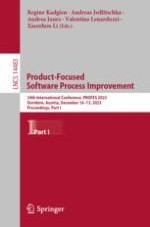2024 | OriginalPaper | Chapter
Status Quo and Problems of Requirements Engineering for Machine Learning: Results from an International Survey
Authors : Antonio Pedro Santos Alves, Marcos Kalinowski, Görkem Giray, Daniel Mendez, Niklas Lavesson, Kelly Azevedo, Hugo Villamizar, Tatiana Escovedo, Helio Lopes, Stefan Biffl, Jürgen Musil, Michael Felderer, Stefan Wagner, Teresa Baldassarre, Tony Gorschek
Published in: Product-Focused Software Process Improvement
Publisher: Springer Nature Switzerland
Activate our intelligent search to find suitable subject content or patents.
Select sections of text to find matching patents with Artificial Intelligence. powered by
Select sections of text to find additional relevant content using AI-assisted search. powered by
